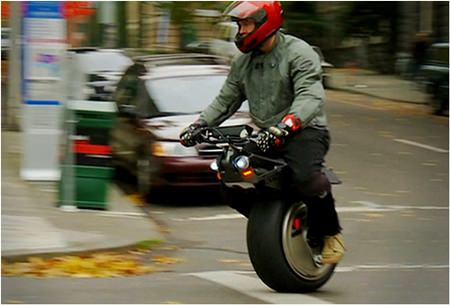With the advent of the Segway a few years ago, personal mobility took on a new technology and direction. Now comes another using similar ‘balancing’ technology, called the AirWheel.
This is a very much smaller device, but don’t let the wheel’s compact design fool you. The machines are packed full of technology. Each unit has inbuilt safety precautions to allow a smooth ride every time. If the user jumps off the unit, the wheel automatically cuts its power and will continually beep to let you know the gyro is no longer in action. Also, the AirWheel units are waterproof for use in the rain and are optimized for riders seeking a cutting edge transportation method. The units are quite literally like nothing else available. When the unit has 10 percent battery left, it will continually beep to indicate the battery is low and telling you to dismount. The unit will never cut out, even if you do not hear the beep. The unit will then gently lean back so the user safely steps off. When going down hill or slowing, the kinetic energy is used to recharge the battery.
 AirWheel
AirWheel
According to the manufacturer, riding the wheel is very similar to a push bike. When stationary, you will fall left or right, but once you lean forward, balancing is easy. AirWheel units are by no means age restricted, they claim to have customers aged from 5 years to 78 years old!
The Q3 is the most popular model. The twin wheels limit users falling left or right, even when in a stationary position! The Q3 even makes it easy to go backwards too. Most users will learn the Air Wheel X series within a day and the AirWheel Q3 dramatically quicker.
So that is the AirWheel, but another development is closer to a motorcycle, and is literally a one wheeled electric motorcycle and is called the Ryno.
The Ryno has a single 25 inch motorcycle tire and reaches speeds up to 16 kph, uses a combination of gyroscope sensors and accelerometers to balance itself. That, combined with a strategic weight distribution and an intuitive acceleration and braking method, those who have tested it in the USA say this makes this motorized unicycle from the future actually feel safe.
It is an amazing looking creation which looks like a motorcycle where the front wheel has gone missing, and has had an interesting development. Ryno CEO Chris Hoffmann said, “My daughter drew a sketch of a one wheel motorcycle she saw in a video game and asked me to build it. She was 13 years old.”
He then went ahead and built it about seven years ago, and finally after four and a half years began the business model.
Rather than use a hand-throttle like a motorcycle, you move the Ryno simply by leaning forward as you would on a Segway or an AirWheel. Leaning forward on the handlebars forces the sensor-balanced wheel to adjust its position for balance, which propels you forward. Braking is as easy as leaning back, but there’s also a hand brake a la standard motorcycle design.
The Ryno takes about six hours to charge up fully using a 12 volt DC charger. That gives it a range of about 16 kilometers per charge at top speed. Real-world usage – stopping, starting, and going at pedestrian speed – will probably yield quite a bit more than that. The removable, rechargeable batteries also power the Ryno’s LED headlights and light-up dash display.
It’s hard to describe what it feels like to ride the Ryno, but the main takeaway is it’s much easier and safer than it seems. The vehicle really does balance itself without a hitch, and getting the hang of leaning forward and backward to accelerate and decelerate takes only a few seconds.
Indeed, the self-balancing skills of the Ryno are reported to be impressive to the point of being miraculous. With the vehicle turned on and no one seated on it, Hoffmann pushed down as hard as he could on the handlebars while standing in front of it. It didn’t even budge on its single wheel as the gyro and motion sensors kicked in. Of course you can still tip it over from side to side fairly easily, but obviously your legs are there for stabilization.
 Ryno
Ryno
A lot of what feels safe about riding the Ryno has to do with weight distribution. The entire vehicle weighs 73 kg, with the wheel-and-motor portion accounting for most of that. That makes it feel extremely bottom-heavy and rooted to the ground. It also makes it easier to pick up. The lightweight seat and frame, which are made from a combination of metal tube and 3D printed parts, rocks back and forth on the wheelbase and absorbs shock.
Will the Ryno catch on? Personally I think riding the unicycle looks ‘safer’ than standing on an AirWheel or Segway, but it is much bigger to make riding on footpaths a problem. As daily transport, they all suffer from leaving the riders basically unprotected if not on dedicated bike lanes, and bike lanes are not a feature of Thailand’s roads.
However, as a pointer towards the future of personal mobility, I believe these gyroscopic transport devices will be the way to go.




